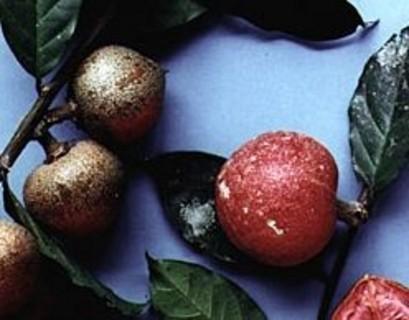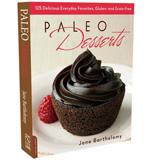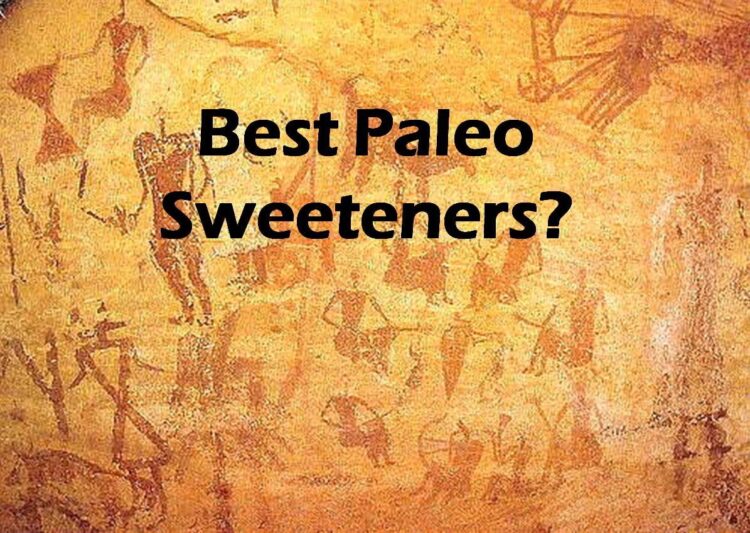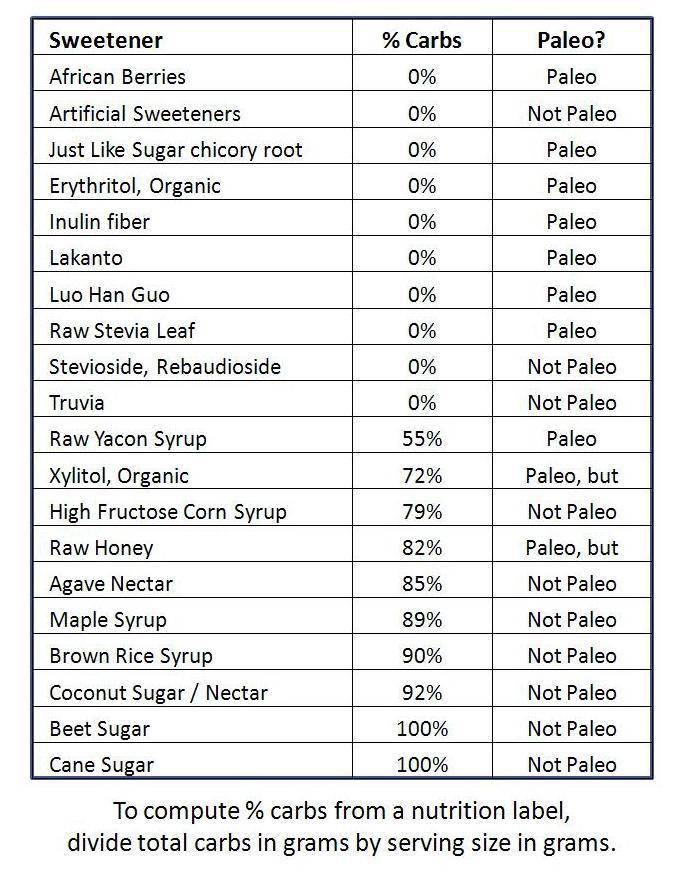The spotlight is on Paleo Sweeteners – minimally processed that don’t raise blood sugar. We live in times when sugars and refined carbs in industrial foods are causing epidemic health challenges worldwide. Many people are turning to the Paleo diet for guidance. What did our ancestors eat? What is the best diet that humans were genetically designed to eat? By following the ancestral diet, many people hope to restore health and balance in their bodies. See also my research in 325 Sweeteners, Which is Best?, and Natural Sweeteners, A Closer Look. I confess that I have a strong bias in favor of low-carb sweeteners because of our modern epidemic of sugar addiction, obesity, and diabetes. Please share your comments below.
True Paleo Sweeteners were hunt-and-gather foods. I’m sure our ancestors enjoyed sweets prepared from plants using their hands and stone tools. We’re looking at the Paleolithic period from 2.6 million years ago to 10,000 years ago. Some preparation and fermentation may have been possible, however it would have been very simple.
Executive Summary: Here are my top recommended Paleo sweeteners – YAY!!!
- Just Like Sugar Table Top – So Sad! This company went out of business. When will we find a better version? This was made of Natural Chicory root fiber with orange peel, calcium, and Vitamin C (0% carbs, Paleo Sweetener) Raised without any chemicals.
- Swerve Sweetener is made of non-GMO Erythritol plus oligosaccharides and natural flavors. You can buy it in some groceries, online distributors, and Swerve Sweet.com. It is not organic.
- Lakanto is made from non-GMO Erythritol and Monkfruit. You can buy it in some groceries, online distributors, and Lakanto.com. It is not organic.
Here’s a list of so-called healthy sweeteners in order of % carb content.
Are these Paleo or not? Sugars are carbs. Send your comments at the bottom.
Here’s my take on each sweetener alphabetically. As usual, the devil is in the details:
African Berries (0% carbs, Paleo Sweeteners)
These amazing African berries are as old as the hills, a clear indication that our ancestors could have enjoyed sweet foods. Their sweetness is not from carbohydrates, but rather from highly concentrated sweet proteins. Recently re-discovered as sweeteners, some have been approved for soft drinks and prepared foods. Some have been industrially synthesized. You won’t find them on nutrition labels, as the sweetness is so concentrated, their miniscule weight is far less than the 0.5 grams per serving required. (Picture 50 lbs. of sugar sweetness on the head of a pin!)
- Katemfe berries are 3,200 times as sweet as sugar, and contain a sweet protein called Thaumatin that is sold under the brand name Talin by Naturex.
- Brazzein berries are 1,000 times sweeter than sugar, and marketed by cweet.com.
- Monellin comes from the African Serendipity Berry is 1,500 times as sweet as sugar, and has already been approved for use in some countries.
- Monatin, a natural sweetener 1400 times sweeter than sugar, comes from the plant Sclerochiton ilicifolius in South Africa.
- Pentadin is a sweet-tasting protein, was discovered and isolated in 1989, in the fruit of oubli (Pentadiplandra brazzeana Baillon), a climbing shrub of tropical Africa. Sweet tasting proteins are often used in the treatment of diabetes, obesity, and other metabolic disorders that one can experience. These proteins are isolated from the pulp of various fruits, typically found in rain forests and are also used as low calorie sweeteners that can enhance and modify existing foods. Pentadin and brazzein were discovered in 1994. Brazzein and Pentadin are extracted from the same fruit however Pentadin is extracted from the fruit after it is heat-dried and Brazzein is extracted from the fresh form of the fruit.
 These African berries are true Paleo sweeteners, plus they’re 100% free of carbs and sugars. I’m intrigued about them but haven’t used them yet. Will these amazing berries make it into our kitchens soon? I WANT these!
These African berries are true Paleo sweeteners, plus they’re 100% free of carbs and sugars. I’m intrigued about them but haven’t used them yet. Will these amazing berries make it into our kitchens soon? I WANT these!
Agave Nectar (Refined, 85% carbs, not Paleo)
This delicious sweetener is made from the agave plant. The juice is heated and hydrolyzed to make a syrup that is comparable in calories to table sugar and about 150% as sweet. Raw agave juice is clearly an unrefined Paleo sweetener. However, once it is boiled down and processed, that’s refined. And it’s surprisingly high in carbs -79% – 95%, often higher than high fructose corn syrup. However the carb content varies as there’s no industry standard for how to produce it. Agave syrup has a low glycemic level so it doesn’t cause a sudden spike in blood sugar. That’s because agave’s main sugar is fructose, which is absorbed more slowly, and is digested in the liver. However new research shows that fructose is even more harmful than table sugar. Doctors say that consuming more than 20 grams (4 1/4 teaspoons) of fructose per day can trigger insulin response, metabolic imbalance, high cholesterol, and weight gain. Stay far away from Agave!
Artificial Sweeteners (0% carbs, Not Paleo)
Sweeteners such as Splenda, Aspartame, Equal, Saccharin, Sweet’N Low, Sucralose, Acesulfame K, NutraSweet, etc. have zero carbs. Artificial sweeteners range from 3 times to 13,000 times sweeter than sugar. We often don’t see high intensity sweeteners listed on packaged food labels. That’s because their miniscule weight is often far below the legal minimum of 0.5 grams per serving, therefore manufacturers are not required to list them. Avoid the Artificial Sweeteners grocery aisle!
Beet Sugar (100% Carbs, Not Paleo)
Beet sugar comes from the plant Beta vulgaris, whose root contains a high concentration of sucrose sugars. About 55% of the white sugar sold in the USA is from GMO sugar beets. Unless your beet sugar is labeled “organic”, it is probably GMO. You can find beet sugar in stores labeled as “sugar”. Cane sugar is usually labeled “cane sugar”, because it is more expensive to produce and considered preferable to GMO beet sugar. GMO Beet sugar is cheaper than cane sugar, and much of it is used by the food industry. Stay far away from this GMO sugar! You can be pretty sure that all restaurants use GMO beet sugar unless otherwise stated on their menu or advertising. Whole Foods Markets and StarBucks are two big users of GMO beet sugar.
Brown Rice Syrup (90% Carbs, Not Paleo)
Also known as rice syrup, this is a sweetener made by cooking rice, straining, and reducing the liquid to a thick, sweet syrup. The final product is 45% maltose, 3% glucose, and 52% maltotriose. That means it’s high in carbs. Rice is a grain, which is not Paleo. Not for human consumption if you value your blood sugar level and your health.
Cane Sugar (100% Carbs, Not Paleo)
Sugarcane is the world’s largest crop. Raw sugar is extracted from freshly harvested cane, bleached, and purified by centrifuging, phosphated or carbonated, filtered, concentrated, and finally dried into crystals. All cane sugar is high-sugar, high-glycemic, and not considered Paleo. This includes organic, not organic, cane juice, cane crystals, raw sugar cane, cane syrup, molasses, and brown sugar. Cane sugar is the #1 top toxin in our modern diet.
Coconut Sugar (Refined, high in fructose, 92% carbs, not Paleo)
Coconut sugar (coconut nectar / coconut crystals) is produced from the delicious sap from cut coconut flower buds. This raw sap is a pure, unrefined Paleo sweetener with a flavor something like Turbinado sugar. To produce commercial coconut sugar, the raw sap must be boiled down or reduced by heating. It requires seven to eight gallons of raw sap to produce one gallon of coconut nectar. Refined coconut sugar is very high in carbohydrates (92%), often even higher than high fructose corn syrup. These numbers vary widely because there is no industry standard for coconut sugar. Coconut sugar has a low glycemic index because it is low in glucose. Its main sugar is fructose, which is absorbed more slowly and digested in the liver. However recent shows that all carbohydrate sugars are toxic to the metabolism, and fructose has the particular harmful effect of causing fat deposits linked to obesity and diabetes. For more details, check out my article: Coconut Sugar, Just a New Name for Sugar? You’re probably getting the idea that I do not recommend refined coconut sugar. Yup. But since Paleolithic rules aren’t carved in stone, they’re open to your interpretation.
Erythritol (0% carbs, Paleo Sweetener)
Erythritol (Ah-REETH-ra-tall) looks and tastes like table sugar. Don’t be fooled by its name, Erythritol is a natural sweetener. It is made by fermenting whole plant pulp into a zero-carb, granulated sweetener that can be used much like sugar. In fact, if you have the starter yeast Moniliella Pollinis you can make this in your own kitchen, sort of like Kombucha. For this reason I consider Erythritol a 100% natural, Paleo sweetener. I’m trying to imagine a Paleolithic cave fermenting system and it’s pretty far-fetched, but not impossible.
Erythritol is 70% as sweet as sugar, so it is measured differently. It takes 1 1/3 cups Erythritol to equal 1 cup table sugar sweetness. Erythritol has a cooling taste, which is wonderful in lemon cheesecake, but somewhat strange in pumpkin pie. It is less likely to cause gastric distress like other fermented sweeteners (such as Xylitol), and it helps prevent tooth cavities. A great bonus! Erythritol can be challenging to work with. It doesn’t dissolve as easily as table sugar, and may develop crunchy crystals if chilled or frozen. This makes it less desirable in chilled desserts. Erythritol can be made of almost any fibrous plant. Sadly, most Erythritol is made from discarded GMO corn stalks. I’d look for organic erythritol for the best quality, but I can’t find it anywhere. If it’s just non-GMO, then it’s probably grown with Monsanto’s Glyphosate or other chemicals – not good. Organic is vastly preferable. These are all rather expensive, but then so is diabetes.
Erythritol Sweeteners I LOVE:
These are three healthy Erythritol sweeteners that I can recommend. Hooray!!! They’re all zero carbs, zero calories. The erythritol is mixed with a high-intensity sweetener to bring the sweetness level up, so that you can measure these cup for cup like Sugar.
- Swerve sweetener is made of non-GMO Erythritol plus oligosaccharides and natural flavors. At this time it appears to be safe for most people. You can buy it in some groceries, online distributors, and Swerve Sweet.com. It is not organic.
- Switch Sweetener by Thrive is made from non-GMO Erythritol, Fructooligosaccharides, and Monk Fruit. It is not organic.
- Lakanto is made from non-GMO Erythritol and Monkfruit. You can buy it in some groceries, online distributors, and Lakanto.com. It is not organic.
High Fructose Corn Syrup (79% carbs, Not Paleo)
Also known as HFCS or Corn Sugar, this includes corn syrups that have been treated with an enzymatic process to make them sweet. Many doctors have raised health concerns about the high use of HFCS in the food industry, alleging that it is linked to obesity, cardiovascular disease, diabetes, and non-alcoholic fatty liver disease. Dr Robert Lustig, endocrinologist at the U of C says fructose is more harmful than regular sugar, contributing to weight gain by overriding appetite controls. Corn syrups in the USA are made from GMO corn. Ooooh – Avoid corn sugar like the plague!
Honey, Raw (82% carbs, Paleo, but high-carb)
Raw, unprocessed honey is a true Paleo sweetener that is twice as sweet as sugar. It is also regarded as a sacred superfood, and a remedy for many health ailments. Our ancestors were willing to take the risk of gathering it from beehives seasonally. But wait a minute – not every day! Honey is very high in carbs and calories, and it will give you a nice big blood sugar spike. It contains roughly 50% fructose, 44% glucose, and 1% sucrose – that’s close to sugar. For this reasons I reserve it as a rare Paleo treat in my recipes. However since there are no Paleo Police, you are free to choose.
Inulin fiber (0% carbs, Paleo Sweetener)
Inulin is a dietary fiber produced from plants such as chicory root and Jerusalem artichoke. Inulin has minimal impact on blood sugar, and is considered a diabetic-friendly aid in managing blood sugar. Inulin is a soluble fiber often prescribed as a prebiotic to promote healthy intestinal flora. This is god! Conversely, it is also considered a FODMAP, a class of carbohydrates which are problematic for certain individuals. For 96% of humans, Inulin fiber is a healthy sweetener.
Just Like Sugar Table Top – Natural Chicory root fiber (0% carbs, Paleo Sweetener)
Just like Sugar Table Top is my favorite natural Paleo sweetener. After testing hundreds of sweeteners I use it because it dissolves easily, it tastes like table sugar, and is easy to measure cup for cup—like table sugar. It’s a pre-biotic, which means it helps to regulate healthy intestinal flora. This can be challenging at first, as some people actually have a detox response at first, however this is temporary. For 96% of humans, JLS is a healthy sweetener, with a few rare exceptions, such as those with unusual microbial balance or SIBO.
The best news is Just Like Sugar has zero-calories and, zero-carbs. It can be used like sugar. It gently sweetens everything, and you’ll get no sugar rush or aftertaste from it. The Table Top version gives the best flavor and texture in desserts. (Better than the Baking version) Let me say right away that I am not paid or endorsed by Just like Sugar in any way – I just love their sweetener. Read about my visit to check out their factory.
Just like Sugar Table Top is made of crystal chicory root that is 96% dietary fiber, mixed with calcium, Vitamin C, and pure orange peel. Orange peel is a highly concentrated sweetener 600 times sweeter than sugar! Chicory root fiber is high in fructo-oligosaccharides, which taste sweet but do not affect blood sugar or cause weight gain. More information.
Just Like Sugar is raised chemical-free, although it is not certified organic. Buy Just Like Sugar Table Top online from JustLikeSugar.com. It is expensive – about $19 per pound, for 4.9 cups. Healthy food is expensive, partly because it’s not subsidized like sugar, corn, etc. And how can you measure the cost of disease? I use Just Like Sugar in my recipes, and you’re free to experiment with YOUR favorite sweetener.
Luo Han Guo (0% carbs, Paleo Sweetener)
Pronounced Lo-Han-GWO, this Chinese herb is a delicious zero-carb, zero calorie sweetener about 20 times sweeter than sugar. Siraitia grosvenorii is also called Monk Fruit, as it was cultivated for centuries by Buddhist luóhàn monks. Luo Han Guo is a 100% natural Paleo sweetener. The dried whole fruit powder has a delicious flavor similar to chocolate or molasses. Grown only in China by international law, Luo Han Guo is used in traditional Chinese medicine as a tonic for the lungs. I suggest caution in buying Luo Han Guo as it is often mixed with other ingredients such as cane sugar or dextrose (a GMO corn sugar). You can buy a good quality Lo Han Guo sweetener from Swanson Vitamins, called PureLo Lo Han Sweetener. It is mixed with inulin powder, and is approximately 6 x sweeter than sugar. Then again you can always be a Paleo purist and buy the whole dried Lo Han Guo fruit from any Chinese herbalist (Ask for Plum Flower brand Momordica Fruit). Grind the whole un-peeled pods into powder using a super blender. It’s delicious! A favorite healthy Paleo sweetener. Hooray!
Maple water, Raw (2% carbs, True Paleo Sweetener)
Pure maple sap has been used for centuries by the American Indians. It is thin and watery with a faintly sweet flavor and a slight taste of maple. It is a clear fluid that flows out of any hole drilled into the tree. Also called Maple water, it is sometimes sold as the new favorite alternative to coconut water and soft drinks. You can find SEVA brand pure maple water at Whole Foods Markets, and other brands online. Raw maple water is so dilute and low in sugars, that it won’t raise anyone’s blood glucose. Maple water is truly Paleo. I don’t use it, as it is not sweet enough to be an effective sweetener.
Maple Syrup, commercial (89% carbs, Refined, not Paleo)
Common maple syrup is refined by boiling the raw sap down into concentrated syrup. The sap is reduced to 2% of its original volume to make commercial maple syrup. It takes 55 gallons of raw sap to produce 1 gallon of commercial maple syrup. Is that Paleo? Maple syrup is very high in carbs – 85 to 93%, and especially high in fructose. The fructose content varies by grade. Maple syrup is a highly regulated industry, and each grade of syrup has a specific sugar content. Since maple syrup is refined and high in sugars, I do not use it in my recipes. I’m looking for a sweetener that will stop sugar addiction in its tracks, and clearly maple is not the one. You’re free to choose. For more details, check out my article: Is Maple Syrup Paleo? My recommendation: stay away from maple syrup if you value your blood sugar and your health.
Norbu Sweetener
This Australian-made sweetener is made from Erythritol and Monk fruit (Luo Han Guo). Norbu sweetener contains 96% fewer carbs and calories as sugar, which is quite impressive. Since Australia DOES allow genetically modified corn, and most Erythritol is made from corn stalks, there’s a chance it is GMO. The label does not indicate it is GMO-free. I don’t know enough to comment. It’s been on the Dr.Oz show and can be purchased at Amazon.com. Please share your comments below.
Stevia Leaf, Green, Unprocessed (0% carbs, Paleo)
The leaves of the South American plant Stevia Rebaudiana are 30–45 times as sweet as table sugar. Pure stevia is available as a potted plant, in bulk dried leaves, or as a fine green powder. This raw, unprocessed stevia is a truly natural, Paleo sweetener. However many people find it has a strong bitter aftertaste something like licorice, which lingers for a time on the tongue, and this perception differs from person to person. You can buy bulk stevia leaves or green powder in food coops and online. You can know it is probably pure and unrefined because it is bright green. Get a stevia plant and grow it on your window sill. You can even make your own stevia extract or stevia syrup. I buy pure green Stevia Powder by Planetary Herbals from VitaCost or find other sellers on Amazon.com. Unrefined stevia is a wonderful Paleo sweetener!
Stevioside / Rebaudioside (0% carbs, refined, Not Paleo)
When the stevia leaf is processed commercially, its sweetness is extracted and concentrated using heat and chemicals. Typically ethanol or methanol are used as solvents to break the cell walls, and the residue is filtered many times. The result is white refined stevioside powder or liquid, sometimes called Rebaudioside. Industrially refined stevioside is 250 – 300 times sweeter than sugar, with zero carbs, and less aftertaste than raw stevia. Refined stevioside is often sold to the food industry in blends with sugar, artificial sweeteners, and/or other chemicals. I suggest you have any so-called “stevia” product professionally analyzed for toxins (formaldehyde, arsenic, etc.) before using it. For more details, check out my article The Toxic Truth About Stevia. I’d stay far far away from refined stevia, and all store-bought or commercial stevia products. Avoid all of them!
Truvia (0% carbs, Not Paleo)
Truvia is a sugar substitute developed by The Coca-Cola Company and Cargill. It is sold as a tabletop sweetener and food ingredient. The main ingredient is corn-based Erythritol. If it is not marked organic, we can assume it is GMO-genetically modified. The additional sweetness comes from natural flavors and Rebaudioside, a refined extract from stevia leaves by a proprietary process that has not been revealed. Totally toxic. Avoid at all costs.
Xylitol (72% carbs, Paleo Sweetener, but not recommended)
This natural granulated sweetener is made from fermented whole plant pulp. Since you can ferment it yourself with the starter yeast Pichia Stipitis, I consider it a Paleo sweetener. Xylitol is widely available. It is sometimes made from hardwoods, but nowadays it is most often made from GMO corn stalks. You can look for a non-GMO brand. Xylitol does not cause tooth cavities, and has a cooling taste. It is measured cup for cup like table sugar and has 70 % the calories of sugar. Since Xylitol is almost as high in carbs as table sugar, it might not help you totally break the sugar habit (I get a sugar rush from it). Xylitol qualities vary and some brands do not dissolve easily, causing crunchy crystals when chilled. Consuming more than 30 to 60 grams (2 1/2 to 5 tablespoons) per day may cause gastric bloating or diarrhea. Xylitol is highly toxic to dogs and may cause liver failure. For these reasons I do not use Xylitol in my recipes. For more details, check out my article Xylitol, Pros and Cons.
Yacón Syrup, raw (55% carbs, Paleo Sweetener)
This delicious syrup comes from a South American tuber root like a potato. Yacón syrup has a natural caramel or molasses flavor. It contains inulin, which has a sweet taste but is low in calories and carbs. Since there is little standardization in the industry, some brands of Yacon are more highly processed, cooked, and therefore higher in carbs. I suggest care in buying it, especially if you are sensitive to sugars. Always look for raw Yacón, which is lower in carbs and sugars. Yacón is optional in my recipes and you should use it at your own discretion. While it is expensive, just one tablespoon adds a distinctive brown sugar flavor, and a small jar lasts me several months. I love raw Yacón syrup in Chocolate Chip Cookies, Pumpkin Bread and Fudge. If you try it I think you will enjoy the rich caramel taste. You can find raw Yacon syrup at some whole food markets, food coops, NavitasNaturals.com or Amazon.com. Hard to find raw. Most Yacon syrup has been boiled down to a sticky sweet concentrate high in fructose, which does not promote health.
See also my articles Best Natural Sweeteners, “Natural” Sweeteners -A Closer Look, and 325 Sweeteners – Which is Best?
(*) To count ALL the sugars, look for Total Carbs on the nutrition label.
This is the best way to measure sugar content. That’s because the FDA measures sugars as monosaccharides and disaccharides only, omitting all the longer chains. Certain sugars and corn syrups can be manipulated to show a low sugar content, by cutting the molecular chain wherever they want and show a much reduced sugar counts. That’s effectively a huge loophole and secret labeling trick for sugars. Therefore, to be sure your count includes all sugars, rely on the carb number from the label, rather than sugars.
The four classes of carbs by molecular structure are monosaccharides, disaccharides, oligosaccharides, and polysaccharides. Monosaccarides are simple sugars like glucose, dextrose, and fructose. Disaccharides are formed when two monosaccharides are joined together. When most carbs are digested, they break down into simple sugars. So the question becomes – where do you draw the line between sugars and other carbs?
Let me know your comments. What’s your favorite Paleo Sweetener?







6 Replies to "Best Paleo Sweeteners"
San November 9, 2024 (3:53 pm)
Hi Jane!
Thanks for all the info. I don’t see allulose listed and wonder what you think of it?
Some Swerve products have an erythritol and allulose blend. Any thoughts?
Jane Barthelemy February 2, 2025 (7:31 am)
Hello San, thank for your question. I have very little experience with allulose sweetener. I believe allulose might be no problem, OK to use. I do like Swerve. But just remember I haven’t tried allulase, so I’m no expert.Best wishes! Jane
tushita November 6, 2024 (6:23 am)
I love “just like sugar’ but it does’t seem to be available any longer. I haven’t been able to find it anywhere for a few years. Do you have any information?
Jane Barthelemy February 22, 2025 (6:48 am)
Hi Tushita, Thanks for your question. The Tale of the demise of Just Like Sugar is just now coming out. I do know someone I trust is creating a new sweetener that might be even BETTER. But it’s too early to say anything. So we are left with 1) poor alternatives or 2) abstaining from sweets. My choice is #2, abstaining. If something does become realized for a new sweetener, it will be a joyful event, the talk of the town, and will be posted here on my blog. Blessings! Jane
CoCoD November 9, 2021 (10:25 am)
Sugar alcohols are not healthy cause digestive upset, are highly processed are not natural, not paleo.
Jane Barthelemy November 17, 2021 (12:32 am)
Hi CoCoD, Thanks for your comment. I agree with you. Trouble is that most people are so addicted to “sugars” we’ll do anything to experience a sweet taste. Erythritol does cause indigestion for some people. Since it does not upset my stomach, I consider it perhaps the most benign of the sugar alcohols. Xylitol is the worst for me. My intestines turn upside down for 24 hours. Believe it or not, you can actually make Erythritol in your kitchen, if you have the exact bacterium – so maybe we can streeeeetch it and call it “Paleo”. Ha Ha! Just joking. Personally I stopped eating all sugars, all sweeteners, and my health keeps improving. Thanks for your comment. Jane